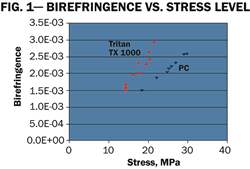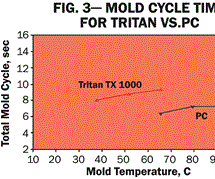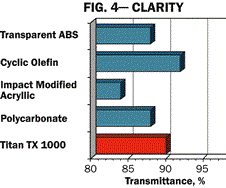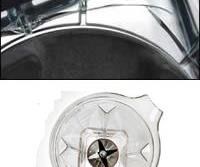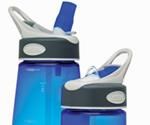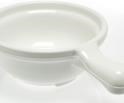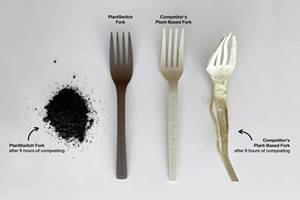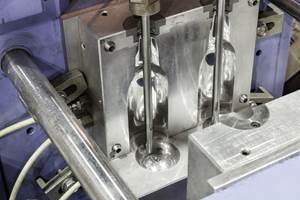Dishwasher Safe: New Clear Copolyester Is Tougher, More Heat-Resistant, and Processes Easier, Too
In consumer goods markets, there are countless applications for clear plastics such as copolyesters, acrylic, SAN, amorphous nylon, and polycarbonate.
In consumer goods markets, there are countless applications for clear plastics such as copolyesters, acrylic, SAN, amorphous nylon, and polycarbonate. However, as new applications call for materials that can deliver durability, design flexibility, and easy processing, existing plastics can fall short. Eastman Tritan copolyester is a new amorphous thermoplastic aimed at filling this gap. It was launched by Eastman Chemical Co. at the recent K 2007 show in Dusseldorf, Germany.
Up to now, copolyesters have often been limited by their low heat resistance. New Tritan resin overcomes this hurdle with significantly increased heat resistance and toughness. Tritan offers exceptional clarity, low haze, high gloss, and consistent color, as well as the potential for faster molding with lower levels of residual stress. This unique balance of performance and processability is well suited to bridge the gap between previous copolyester families and other clear plastics such as polycarbonate.
Designed with a higher glass-transition temperature (Tg) than traditional copolyesters, Tritan delivers greater heat resistance without sacrificing the chemical resistance and low internal stress found in copolyesters
Products molded from Tritan have less residual stress than ones molded in other types of thermoplastics, such as polycarbonate. Combined with its superior chemical resistance, this lower residual stress level can significantly reduce the risk of product failure from environmental stress cracking (ESC). In molded polycarbonate products, ESC is often controlled through an annealing process or significant design modifications—compromises that can be largely eliminated through the use of Tritan copolyester.
Produced from a new, patented monomer, Tritan copolyester is the first of a new family of materials. Thus far, it has been shown to be suitable for injection molding, injection-blow and stretch-blow molding, sheet and flat film extrusion, and thermoforming. It is available in commercial quantities and in several grades designed for different markets. The grades differ in Tg, melt flow rate, and incorporation of mold release.
Putting it to the test
Eastman’s Tritan offers many benefits for commercial and residential kitchenware and small kitchen appliances, including reusable food containers, sports bottles, mugs, pitchers, and containers for food processors and blenders. These products often require extremely versatile designs and shapes, exceptional clarity for vivid aesthetics, and dishwasher durability—one of the biggest challenges to kitchenware design.
Dishwashers in homes and professional kitchens expose kitchenware to a harsh combination of heat, hydrolytic and chemical attack, and applied stress. In some cases, kitchenware is exposed to the dishwasher dozens of times per week. Withstanding these environmental conditions was a major design goal in the development of Tritan.
When developing this new material, Eastman tested products made with Tritan in dozens of commercial and residential dishwashers. Samples of Tritan and other materials were subjected to multiple washings simulating overloaded dishwashers. Results demonstrated that Tritan’s unique balance of properties allows molded items to withstand hundreds of cycles in commercial and consumer dishwashers with no visible crazing or cracking, a vast improvement over polycarbonate.
How it compares
Although Tritan is a copolyester, it is similar to polycarbonate in many important respects. For example, polycarbonate has a reputation for high heat resistance and toughness. In notched Izod testing with 1/8-in. bars, polycarbonate can withstand impact of 14 ft-lb/in. with a partial break, as opposed to less than 5 ft-lb/in. for traditional copolyesters. In the same test, Tritan can resist an impact of 15.9 ft-lb/in. without breakage.
Interestingly, increasing the sample specimen thickness to 1/4 in. provides significantly different notched Izod results. Bars molded from polycarbonate withstood only 2.2 ft-lb/in. while Tritan displayed no break or partial break at impacts of 15.9 ft-lb/in. Thickness sensitivity with regard to impact toughness is a well known characteristic of polycarbonate that does not affect Tritan copolyester.
Another indication of toughness is elongation at break. Polycarbonate has a break elongation of 110% to 120%, while Tritan has a break elongation of 150% to 170%.
Although Tritan equals or exceeds polycarbonate in impact tests, that does not tell the whole story. A tough material does not necessarily guarantee a durable product. Products molded in polycarbonate are at greater risk of ESC, particularly in more intricate shapes. This is because polycarbonate parts may experience significantly higher levels of residual stress than parts molded of Tritan.
Figure 1 presents data generated during experiments to measure the stress-optical coefficient in Tritan. The stress-optical coefficient enables evaluation of residual stress levels in molded parts based on comparison of birefringence within the parts, a common tool for assessing part quality. The stress-optical coefficient for Tritan is significantly higher than for polycarbonate (164 vs. 97.2). However, the coefficient is inversely related to residual stress level. As a result, parts molded from Tritan having birefringence patterns equivalent to those seen in polycarbonate would possess lower residual stress, thereby improving the ESC performance of Tritan.
Testing revealed that under a 1% strain, polycarbonate often breaks after two to three dishwashing cycles in a residential dishwasher using a common household detergent. Under the same conditions, Tritan endures more than 250 cycles with no sign of crazing or breakage.
While products molded in traditional copolyesters tend to have less residual stress than polycarbonate, they are also less resistant to heat. The Tg of most copolyesters is around 80 C, as opposed to a Tg of 150 C for polycarbonates. The first Tritan product launched has a Tg of 108 C (Fig. 2), again significantly changing the performance profile of copolyesters.
Higher Tg offers several other benefits, including reduced creep under load, reduced molding cycle time, and slower physical aging (Fig. 3).
Clarity (Fig. 4) is measured by light transmittance according to ASTM D1003. Tritan, polycarbonate, cyclic olefin copolymer (COC), and PETG all exhibit very high levels of light transmission. Clear ABS and impact-modified acrylic display lower transmittance due to their multi-phasic nature.
Tritan also exhibits scratch resistance that is much better than SAN and slightly better than polycarbonate. Together with its toughness and chemical resistance, this property suggests potential uses in face masks and other sports or safety applications.
Benefits for molders
Tritan is good news for OEMs, designers, and consumers, but the new copolyester also provides substantial benefits to molders. It can reduce costs by eliminating production steps and lowering material use, shipping weights, and inventory volumes. It can also deliver faster molding cycles than many other transparent plastics. One customer experienced a nearly 20% improvement in cycle time with Tritan as compared with polycarbonate parts produced in the same mold. Tritan’s melt flow is generally similar to that of polycarbonate, and its similar shrinkage allows it to be used in the same molds. It molds well with hot runners and small gates. It also thermoforms well with deep draws.
| Tritan Copolyester | |
| Preliminary Data Sheeta | |
| General Properties | |
| Specific Gravity | 1.18 |
| Mold Shrinkage | 0.005 in./in. |
| Mechanical Properties | |
| Tensile Strength | |
| @ Yield | 6200 psi |
| @ Break | 7700 psi |
| Elongation | |
| @ Yield | 6% |
| @ Break | 210% |
| Flexural Yield Strength | 9000 psi |
| Tensile Modulus | 225,000 psi |
| Flexural Modulus | 225,000 psi |
| Izod Impact Strength | |
| Notched, 73 F | NB |
| -40 F | 2.4 ft-lb/in. |
| Unnotched, 73 F | NB |
| -40 F | NB |
| Thermal Properties | |
| HDT @ 66 psi | 210 F |
| @ 264 psi | 185 F |
| Optical Properties | |
| Total Transmittance | 90% |
| Haze | <1% |
| Typical Processing Conditions | |
| Drying Temperature | 190 F |
| Drying Time | 4-6 hr |
| Melt Temperature | 500-540 F |
| Mold Temperature | 100-150 F |
| aUnless otherwise noted, all tests performed at 73 F and 50% R.H. | |
Tritan can be injection molded faster than polycarbonate in thick sections without concern for residual stresses. Tritan’s lower stress levels eliminate the need for an additional annealing step after molding (requiring expensive annealing ovens), thereby reducing energy use and overall processing time, lowering costs, and increasing production rates. And with a 2% lower density than polycarbonate, Tritan also yields more parts per pound of resin, which can contribute to material savings.
For both extruded sheet applications and molded products, Tritan does not require predrying before thermoforming. Products can be thermoformed faster and at lower temperatures than polycarbonate sheet. The result is superior material distribution and increased design flexibility when using decorative paints and inks.
Dishwasher-safe
Products exposed to dishwashers must withstand heat, humidity, detergent chemicals, food, in-mold stress, and abrasion from overpacking, along with hydrolytic attack. Commercial dishwashers reach peak temperatures of about 85 C and cycle for 1 to 2 minutes. Residential units reach peak temperatures around 70 C and have cycles of up to 2 hours. Also, kitchenware used in restaurants and commercial kitchens can be washed several times a day.
Figure 5 shows the varying effects of dishwashers on a blender carafe molded in different materials. The polycarbonate container shows cracks after 10 wash cycles, but the Tritan container shows no cracks after 100 cycles. Astonishingly, containers made with this new material have been tested in over 500 wash cycles with no cracks or hazing.
Tritan in the real world
One of the first commercial applications for Tritan copolyester comes from California-based CamelBak, a provider of hydration systems for consumer, government, and industrial applications. CamelBak recently partnered with Eastman to develop the injection stretch-blow molded CamelBak Better Bottle product line using Tritan.
Since the CamelBak Bottle was first launched in polycarbonate, the company has received requests from consumers for both improved dishwasher durability and a product free of bisphenol-A (BPA), a chemical used to make polycarbonate that has been linked to potential health concerns. These requests caused CamelBak to turn to Eastman for alternative material ideas. Tritan was the answer, providing a BPA-free material that also has greater durability to withstand rugged use and dishwasher cleaning. The new CamelBak Better Bottle is scheduled to launch in early 2008 in North America.
Another early application comes from the Vita-Mix Corporation, a producer of high-end kitchen blenders for household and commercial use. Vita-Mix is currently manufacturing blender containers for the newly developed Vita-Mix 5200 model using Eastman Tritan copolyester. Vita-Mix, whose brand is strongly associated with healthy, pure living, sought out a BPA-free material for its new blender. The new-generation copolyester also delivers excellent toughness to stand up to the rigors of the blending process and washing, in addition to superior chemical resistance and improved sound dampening that ameliorates blender noise. The Vita-Mix 5200 is scheduled to launch by the end of this year.
A third application, which is due to launch in 2008, is a thick-walled soup bowl from Carlisle Food Service Products. Used in restaurants, hotels, and catering, the bowls have previously been molded of polycarbonate, polycarbonate/PET blends, and SAN. An important criterion is the ability to be washed several times per day in commercial dishwashers. Tritan molds faster and has lower density than some materials Carlisle has used in soup bowls. Tritan can also be used in the same molds as those materials.
Less environmental impact
Reducing overall impact on the environment is a goal up and down the supply chain. Tritan has some features that contribute positively in this regard. The new-generation copolyester is less dense than materials such as polycarbonate, thus using less material to make the same products. Additionally, the material can eliminate steps in processing such as annealing, which can reduce overall energy usage.
David S. Porter, Ph.D., is principal applications development representative, and Randy S. Beavers is business development manager, in the Specialty Plastics Organization of Eastman Chemical Co. in Kingsport, Tenn.
Related Content
Prices for All Volume Resins Head Down at End of 2023
Flat-to-downward trajectory for at least this month.
Read MoreAdvanced Biobased Materials Company PlantSwitch Gets Support for Commercialization
With participation from venture investment firm NexPoint Capital, PlantSwitch closes it $8M bridge financing round.
Read MoreLanxess and DSM Engineering Materials Venture Launched as ‘Envalior’
This new global engineering materials contender combines Lanxess’ high-performance materials business with DSM’s engineering materials business.
Read MoreThe Importance of Melt & Mold Temperature
Molders should realize how significantly process conditions can influence the final properties of the part.
Read MoreRead Next
For PLASTICS' CEO Seaholm, NPE to Shine Light on Sustainability Successes
With advocacy, communication and sustainability as three main pillars, Seaholm leads a trade association to NPE that ‘is more active today than we have ever been.’
Read MoreBeyond Prototypes: 8 Ways the Plastics Industry Is Using 3D Printing
Plastics processors are finding applications for 3D printing around the plant and across the supply chain. Here are 8 examples to look for at NPE2024.
Read MorePeople 4.0 – How to Get Buy-In from Your Staff for Industry 4.0 Systems
Implementing a production monitoring system as the foundation of a ‘smart factory’ is about integrating people with new technology as much as it is about integrating machines and computers. Here are tips from a company that has gone through the process.
Read More




